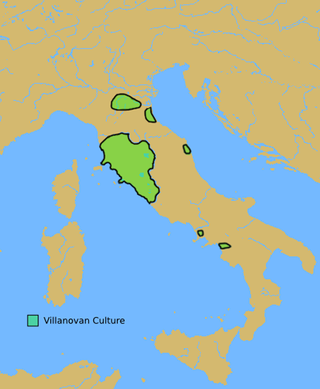
Anzio is a town and comune on the coast of the Lazio region of Italy, about 51 kilometres (32 mi) south of Rome.

Palestrina is a modern Italian city and comune (municipality) with a population of about 22,000, in Lazio, about 35 kilometres east of Rome. It is connected to the latter by the Via Prenestina. It is built upon the ruins of the ancient city of Praeneste.

Antium was an ancient coastal town in Latium, south of Rome. An oppidum was founded by people of Latial culture, then it was the main stronghold of the Volsci people until it was conquered by the Romans.

Civitavecchia is a city and comune of the Metropolitan City of Rome in the central Italian region of Lazio. A sea port on the Tyrrhenian Sea, it is located 60 kilometres west-north-west of Rome. The harbour is formed by two piers and a breakwater, on which stands a lighthouse.

The Via Clodia was an ancient high-road of Italy. Situated between the Via Cassia and the Via Aurelia, it is different from them notably in that the latter was designed primarily for military long-haul, irrespective of settlements they met, but the Via Clodia was of short-range, intended for commercial traffic with the colonies in Etruscan lands.

Bolsena is a town and comune of Italy, in the province of Viterbo in northern Lazio on the eastern shore of Lake Bolsena. It is 10 km (6 mi) north-north west of Montefiascone and 36 km (22 mi) north-west of Viterbo. The ancient Via Cassia, today's highway SR143, follows the lake shore for some distance, passing through Bolsena. Bolsena is named "the city of the Eucharistic miracle" from which the solemnity of Corpus Domini had been extended to the whole Roman Catholic Church.

Formello is a town and comune in the Metropolitan City of Rome. It is located southwest of the Monti Sabatini, within the Regional Park of Veii. The communal territory sits on large deposits of tuff, which is intensively mined in the area.

Tuscania is a town and comune in the province of Viterbo, Lazio Region, Italy. Until the late 19th century the town was known as Toscanella.

The Villanovan culture, regarded as the earliest phase of the Etruscan civilization, was the earliest Iron Age culture of Italy. It directly followed the Bronze Age Proto-Villanovan culture which branched off from the Urnfield culture of Central Europe. The name derives from the locality of Villanova, a fraction of the municipality of Castenaso in the Metropolitan City of Bologna where, between 1853 and 1855, Giovanni Gozzadini found the remains of a necropolis, bringing to light 193 tombs, of which there were 179 cremations and 14 inhumations.

Saturnia is a spa town in Tuscany in north-central Italy that has been inhabited since ancient times. It is a frazione of the comune of Manciano, in the province of Grosseto. Famous for the spa which gives it its name, its population is 280.

Lucus Feroniae was an ancient sanctuary or, literally sacred grove ("lucus"), dedicated to the Sabine goddess Feronia, protector of freedmen, ex-slaves. It was located near to the ancient town of Feronia in Etruria on the ancient Via Tiberina, in what is now the territory of the modern commune of Capena, Lazio.

Ranuccio Bianchi Bandinelli was an Italian archaeologist and art historian.
Giovanni Becatti was an Italian Classical art historian and archaeologist.

Orte is a town, comune, former Catholic bishopric and Latin titular see in the province of Viterbo, in the central Italian region of Lazio, located about 60 kilometres (37 mi) north of Rome and about 24 kilometres (15 mi) east of Viterbo.

Feronia or Lucus Feroniae was an ancient town near the present town of Fiano Romano. It is located in the plain along the Tiber river, at the foot of Mount Soracte, and was within the ancient territory of Capena. It began as a sanctuary called Lucus Feroniae in the time of Tullus Hostilius when it was located in Etruria.

The National Etruscan Museum is a museum of the Etruscan civilization, housed in the Villa Giulia in Rome, Italy.

Luni is a comune (municipality) in the province of La Spezia, in the easternmost end of the Liguria region of northern Italy. It was founded by the Romans as Luna. It gives its name to Lunigiana, a region spanning eastern Liguria and northern Tuscany.

San Giovenale is the modern name of the location of an ancient Etruscan settlement close to the modern village of Blera, Italy. It was excavated by the Swedish Institute at Rome in the 1950s and 1960s with King Gustaf VI Adolf as one of the participating archaeologists. The excavations at San Giovenale has been, together with the excavations of Acquarossa, the main source of information about how small and medium-size Etruscan settlements were organized. The finds from the excavations are now partly exhibited in the Etruscan Museum of the Rocca Albornoz in Viterbo.

Norchia is an ancient Etruscan city with an adjacent necropolis, near Vetralla in Italy. The site is along the Via Clodia, and is not far from the more well known Etruscan town of Tarquinia.

The ancient Roman Villa dei Volusii or Villa dei Volusii-Saturnini is an archaeological site located in the municipality of Fiano Romano, next to the ancient Roman town and sanctuary of Lucus Feroniae, along the route of ancient Via Tiberina.























